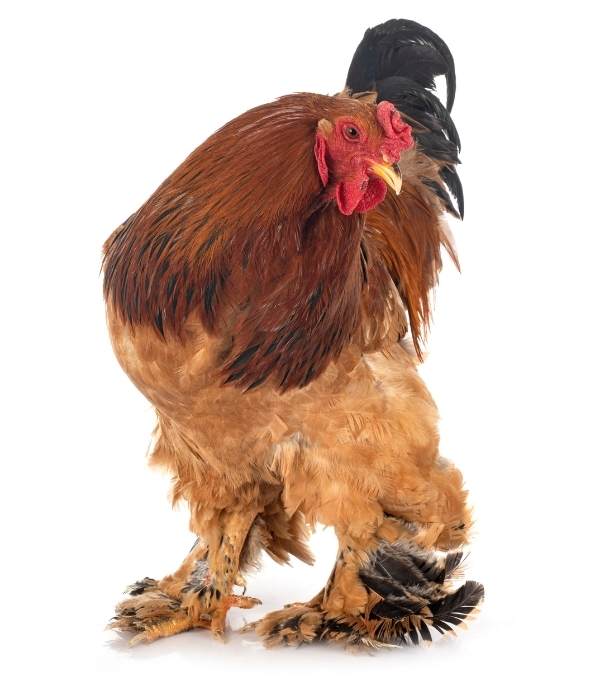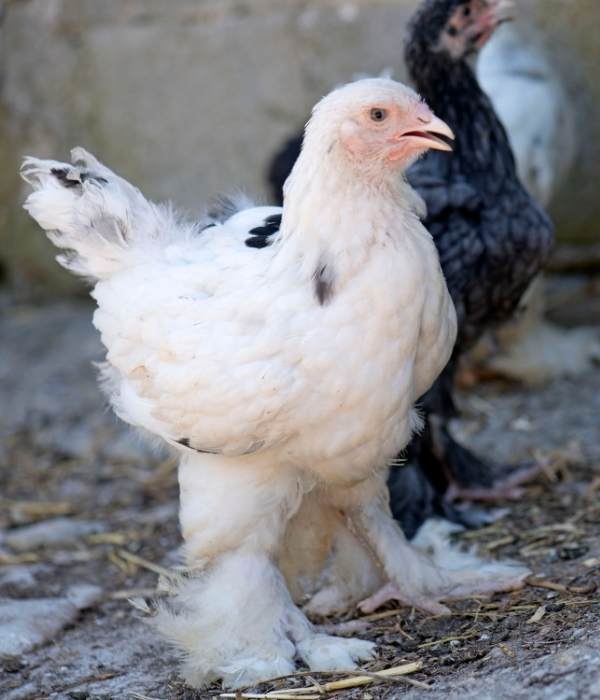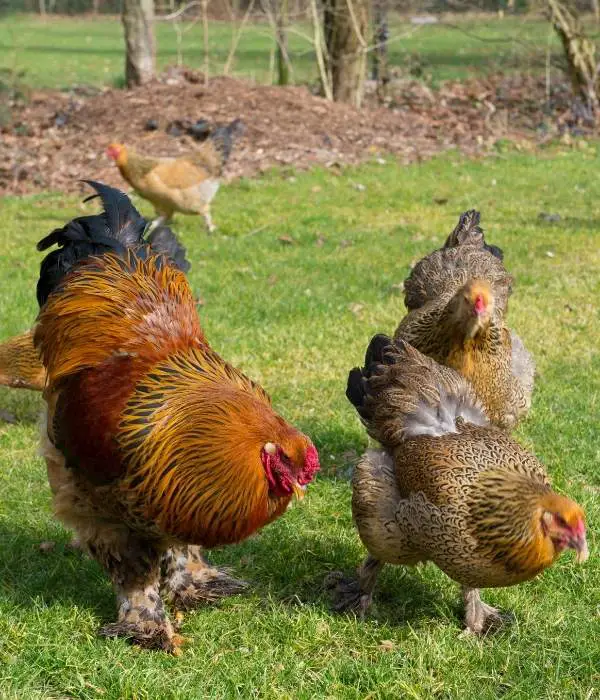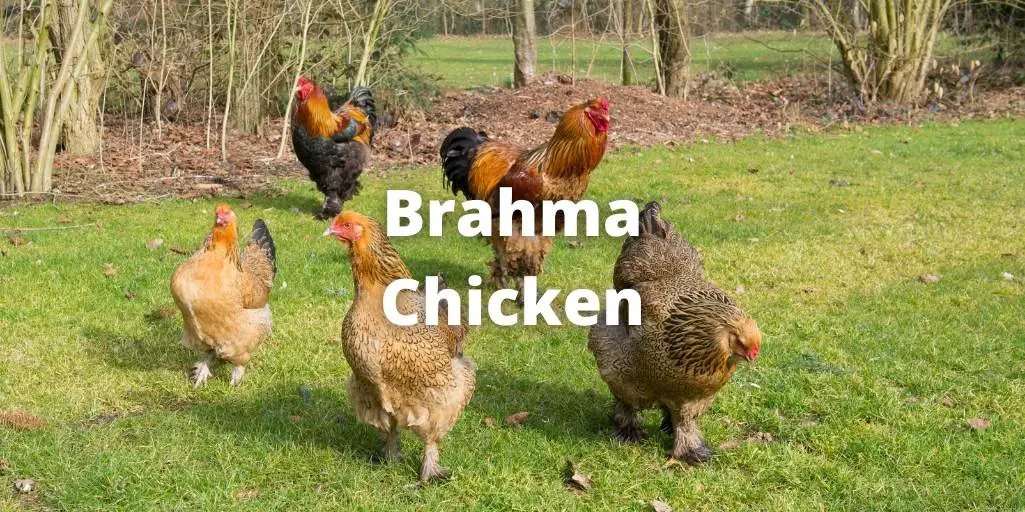The Brahma chicken, known as a king amongst its kind, is considered a heritage bird by the American Poultry Association because of its pre-mid-twentieth century beginnings.
Despite its formidable demeanor, it’s an extremely large and stately chicken, although it’s been dubbed a ‘gentle giant.’
Principally a table bird until the 1930s, it is a staple for any backyard flock. They are large and intimidating enough to protect and even defend the flock from small predators.
In this guide, we have explained all about Brahma chickens. It includes history, color varieties, lifespan, egg production, characteristics, size, and care guide.
What is a Brahma Chicken?

The Brahma chicken is an exceedingly large breed of chicken developed in America. Often referred to as “Shanghai” chickens having been imported from the Chinese port of Shanghai.
These handsome birds are gentle enough even for beginning hobbyists and can be reared for the dual purpose of both meat and eggs.
These hardy chickens are good egg-layers, and before the rise of the industrial birds of the 1930s, they were the preferred meat chicken breed.
Though no longer the favored industry bird, they retain popularity in smaller flocks and families who enjoy the breed as a multipurpose pet.
Brahma roosters are one of the best in the world.
History and Origin of the Brahma Chicken
The Brahma chicken is a breed whose origins are fraught with controversy, but it is now established that the Brahma was imported from the Chinese port of Shanghai in the 1840s, resulting in the nickname ‘Shanghai’ chicken.
These large birds were then developed and bred in America. It is assumed that the pea comb and certain distinctive characteristics of the shape of the head were the results of cross-breeding the fowl with Chittagong birds from Bengal (now Bangladesh).
These characteristics differentiate it from the Cochin, also derived from the birds imported from the Shanghai port.
With a plethora of different names and strains of the breed, Boston poultry judges met in 1952. They decided to name it the ‘Brahmapootra,’ derived from the Indian river called the Brahmaputra.
The breed’s new name was subsequently shortened to ‘Brahma.’ Around this same time, Brahmas were imported to England for the first time when a man named George Burnham, seeking to gain acclaim for his stock, sent a gift of 9 of his finest gray birds to Queen Victoria.
With these birds dubbed ‘Gray Shanghaes,’ English breeders developed the Dark Brahma variation from them, which were later exported back to the U.S.
For a period totaling about 70 years and ending in about 1930, Brahma chickens were considered the ultimate breed for meat. Back in the 1800s, when the breed was even larger than it is now, a single chicken could feed a moderate to large family quite easily.
The rise in industrial agriculture and the inability of the Brahma birds to put on size and muscle at a pace in keeping with faster-growing breeds caused the Brahmas to fall out of favor.
They may no longer be the choice for factory farms. Still, their status is now listed as ‘recovering’ in the Livestock Conservancy directory thanks to the upsurge in popularity with keepers of smaller flocks and homesteaders.
Recognized Varieties of Brahma Chickens

As recognized by the American Standard of Perfection, there are three varieties of the Brahma chicken: light, dark, and buff. In 1865 the British Poultry Standard published both the light and dark varieties as the official Poultry Club.
These dark and light varieties of the Brahma breed were also included 9 years later, in 1874, into the American Poultry Association standard. It wasn’t until 1924 that the Buff Brahma variant was added.
There are several varieties that the American Poultry Association does not recognize, such as the buff laced, silver laced, and gold-laced varieties.
Different varieties, including the Partridge, Blue, Black, Barred, and Crele variations, have been accepted by the Australian Poultry Association.
Also read: All about Light Brahma chicken breed
Lifespan of the Brahma Chicken
The average lifespan of a Brahma chicken is about 5-8 years, although it is not uncommon for them to liver longer, up to 10-12 years.
Brahma Chicken Eggs: Count, Size, and Color
While it can take around 7 months before Brahma hens are ready to begin laying for the first time, they are fairly prolific layers, averaging 3 to 4 eggs a week, or around 150 eggs annually.
Unlike other breeds that stop egg production in the winter months, Brahma hens prefer to lay eggs from October to May.
The eggs are of medium size and brown. The hens are not known for broodiness, but when they do, on occasion, turn out to be the broody type, they will sit on the eggs unwaveringly until they are hatched.
It is advisable to make sure the large hens do not accidentally trample the small baby chicks.
Temperament of the Brahma Chicken
Reportedly, Brahma chickens are intelligent and possess a sweet and calm disposition. They are good-natured around children as pets and can grow quite attached to their owners.
They are not opposed to being handled, enjoy the attention, and do not mind begging for the occasional treat. Their friendliness and even temperament make them an excellent choice for a family pet.
They are very quiet, which makes them suitable for urban apartment dwellers. Because they do not fly and are so large in size, containing them presents a little difficulty.
Color, Size, Appearance, and Characteristics of the Brahma Chicken

Color
Brahma chickens come in three recognized color classifications: light, dark, and buff. While they can be found in other colors such as gold, blue, or black, these variations are not officially recognized.
Size
Often growing to an imposing height of 30 inches (2.5 feet tall), Brahmas are an exceptionally large breed of chicken. Roosters usually weigh in at about 12 pounds, with the hens averaging about 10 pounds.
These birds were even larger back in the 1800s, with recorded weights for the roosters reaching an impressive 18 pounds and hens weighing up to 13 pounds.
Appearance
Brahma chickens are very large, robust birds with thick, flowing plumage. They have a large, broad head with a small pea comb and a protruding ‘beetle brow,’ meaning their brow juts out, giving them a sullen look.
Brahmas have a short, powerful, yellow beak and feathers covering their shanks and toes. They are lovely, cute chicken breeds.
This chicken breed comes in multiple colors, the most recognized as light, dark, and buff, but can also be found in white, blue, black, gold, barred, and partridge variations.
Characteristics
- The body of the Brahma chicken is long, deep, and broad. It has an impressive, upright posture, and when you view the long, feathered legs from the side, they have a narrow V-shaped appearance.
- The light Brahmas have dark hackles on their white base coat, striped, black saddle feathers, and a black tail.
- Buff Brahmas have the same patterns of black coloration in their feathers as the light varieties do, but instead of a white base coat, theirs is a golden buff color.
- The dark Brahmas have primary white-edged feathers and shoulders that are white. Still, they feature a few noteworthy differences between the roosters and the hens: the roosters have hackles and saddle feathers in black and white with the tail and base coat being black, while the hen’s sports black and grey coloration and hackles that resemble that of the light Brahma birds.
Benefits of Raising Brahma Chickens

Brahma chickens are large, docile birds that are not flighty and tolerate confinement well, although they enjoy roaming around and foraging for food.
Friendly and tame enough to keep as pets, Brahma chickens are regarded as downright ‘huggable,’ with their sweet-natured dispositions and their bounty of dense, fluffy plumage.
Even the roosters are known to have friendly dispositions, and the birds get along well with other chickens. Many different breeds exhibit strong panic responses to being picked up and handled.
Not so with Brahma chickens, as they will settle down quite readily when you pick them up, calmly allowing you to hold them.
These graceful and dignified birds are also beautiful to look at with attractive coloration and feathered legs and feet. They are very regal and often described as the ‘king of all poultry’.
With a ‘necklace’ of black hackles, distinctive and attractive color combinations, and long, feathered legs, these chickens are quite striking, especially since they grow to a distinguished height of 30 inches.
Brahmas have a dual purpose: being both meat and egg providers. Hens can be kept to lay eggs, 3 or more a week, with up to 150 eggs a year, while the roosters can be butchered for meat.
These chickens are also a very hardy breed, even suitable for northern climates. With its pea comb and tight, dense feathering, it is one of the breeds the least affected by exposure to the cold.
Another thing to note is that while Brahma chickens are known for their great size, the bantam Brahmas provide a much smaller size option if you would love to own some Brahmas but aren’t in a position to deal with them such large birds.
The bantam males weigh about 38 ounces (a little over 2 pounds), and the females weigh even less (about 34 ounces).
Problems with Raising Brahma Chickens
Brahma chickens are slow to mature taking 7 months before they lay for the first time and up to two years before they are fully grown.
While these chickens deal with cold weather well, the feathers on their feet can stay wet as they walk through mud and snow, leading to the development of small frozen balls on their feet, which can cause frostbite in extreme cases.
Their feathered legs can also make scaley leg mites a problem, so it is advisable to keep a close eye out for this. If you see, you can use suitable medicine for chicken worm infestation.
The long quill feathers on their feet are prone to snagging, and if caught on something, they can be pulled off. Bleeding can occur in these cases and should be treated with styptic powder or corn starch.
Their size and heavyweight can make Brahma chickens more prone to bumblefoot, an infection that medical professionals refer to as ‘plantar pododermatitis’. Feet with scabs or swelling are characteristics to look out for.
Brahma Chicken Care Guide
One thing to consider when raising Brahma chickens is their large size, and they will need more living space than smaller breeds, and the construction should be durable enough to support their considerable weight.
These stout birds are very poor fliers, so only a 3-foot fence is required to contain them. Regular examinations of their legs and feet are necessary to ensure that the feathers that cover them do not hide injuries or parasites.
Brahmas have large appetites, enjoy free feeding, and consume up to a third of a pound of feed a day. While they enjoy foraging insects and worms, this will not sustain them, so they should also be provided with commercial chicken feed containing 16% to 18% proteins.
It is recommended that approximately 5-6 feet of space per chicken is available in the chicken coop to alleviate feather picking and pecking behavior amongst the birds.
Perches should be fairly low, around 12-18 inches in height, as these birds do not fly well and struggle to reach higher perches.
Nesting boxes should be a minimum of 12 “X12”, and even larger, if possible. These should also be situated low to the ground for reasons previously stated.
Brahmas tolerate confinement well but enjoy roaming and foraging, so the outside coop should provide at least 12-14 feet of space per chicken. The pen should ideally be made of sand or stone as dirt floors are likely to become very muddy quickly, leading to potential foot problems in the feathered feet of these birds.
In Conclusion
Brahma chickens are very affordable, although their size makes for steeper housing and feeding requirements. Their cost depends largely on the age, gender, and color variation, with most dark, light, and buff-colored chicks costing about $3-$5 per chick.
Older birds range from as low as $7 for adolescents to as much as $25 for adults. Brahma chickens are available from many hatcheries, including breeders affiliated with the American Brahma Club.


